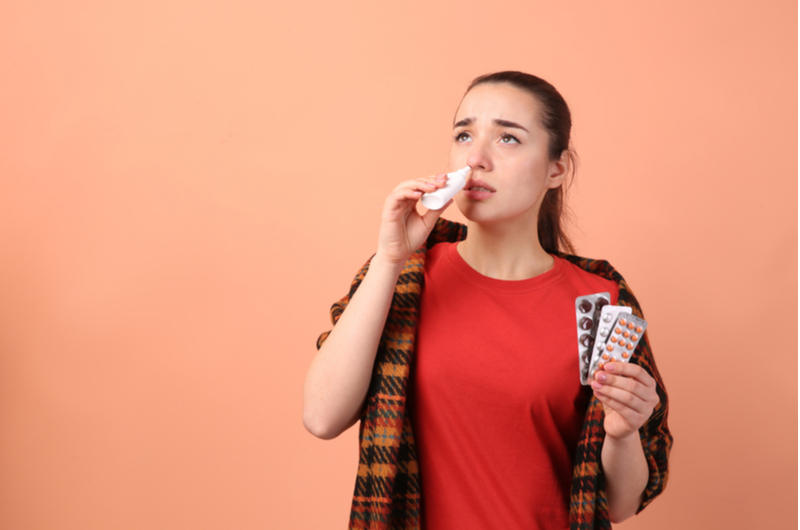Discover some of the most common types of allergies and what causes reactions. Learn ways to treat your allergies, including top medications.
Allergies occur when your immune system has a reaction to a normally harmless trigger. Some of the most common allergies are pollen, mold, animal dander and foods. Allergies are fairly common, with an estimated 20 percent of Americans experiencing allergic reactions. Some reactions only occur if you come in contact with your trigger, while others require you to inhale or swallow the substance. The type of symptoms vary depending on the individual and the severity of the allergy. How long you are exposed can also impact the symptom.
There are a few common symptoms, no matter the type of allergy. This includes itchy and watery eyes, sneezing or a runny nose. Some allergies have more severe effects, making you feel fatigued and lethargic. Skin allergies can also result in an outbreak of rashes or hives, while food allergies can result in an upset stomach. Some individuals have stronger allergic reactions, known as anaphylaxis. The symptoms are the same, but hit much harder. Coughing turns to wheezing and difficulty breathing, while rashes or hives breakout all over the body. 
Pollen
One of the most common allergies in the United States is pollen. The official name for a pollen allergy is seasonal allergic rhinitis. Outside of the medical community, it is commonly called hay fever. The most common symptoms of hay fever are inflammation along your nose and eyes. This leads to sneezing, coughing, watery eyes and feeling congested. Many individuals with pollen allergies try to stay inside when pollen counts are high. If you are unable to avoid pollen, there are several over the counter medications to alleviate symptoms.
Dust Mites
Dust mites are microscopic organisms that reside in dust particles. They prefer warm, humid areas, like carpet fibers or under furniture. Dust mite allergies share symptoms with pollen allergies. Thorough cleaning is one way to reduce dust allergies. Certain vacuum cleaners are designed to remove dust mites from your carpet and furniture. There are also over the counter medications to treat dust allergies.
Mold
Mold is a tiny fungus that grows in damp areas. It can occur both inside and outside, but causes more issues when it is inside, since it can infect an area. There are a few places mold normally grows, with basement, kitchens and bathrooms being the most common offenders. Excessive water damage can cause mold. Basements frequently experience mold growth after a flood. Outside, mold can grow in a number of places, including patches of grass, leaf piles, hay, mulch or underneath mushrooms. The spores peak in hot and humid weather.
Mold allergies commonly result in harsher symptoms. Many individuals with mold allergies experience cold or even mild flu symptoms after exposure to mold. Part of the reason mold allergies are more severe is mold outbreaks are hard to detect, often occurring underneath tiles, floors or within walls. As a result, it’s easy to be continually exposed to mold without realizing it.
Animal Dander
Animal dander typically affects the skin, but it can also cause congestion or watery eyes. There are a few methods to limit danger, such as air cleaners. There are also a number of cleaning products, for both homes and pets, to eliminate dander. Several medications exist to suppress or relieve symptoms, but the effectiveness varies from person to person.
Food Allergies
Food allergies occur when your body produces an antibody that reacts to specific foods. Symptoms from food allergies occur quicker than other types of allergies, often taking a few minutes. Some allergies are mild, but many suffer from severe reactions. Individuals may experience flu-like symptoms, become nauseous or even experience breathing issues, depending on the severity. Some of the most common food allergies include milk, wheat, eggs, soy, shellfish and nuts. If you have a severe allergy, speak with your doctor about treatments. Some individuals are prescribed an injectable epinephrine to combat allergic reactions.
Immunotherapy
If you suffer from stronger allergic reactions, one treatment option is immunotherapy. As of writing, immunotherapy is mostly used for grass, pollen, dust mites and bee venom. However, some scientists have reported successfully treating select food allergies with immunotherapy. During the treatment, you are exposed to small amounts of whichever substance you are allergic to. This allows your body to develop a blocking antibody, reducing your symptoms in the future. Immunotherapy is not an option for all patients. Your doctor will determine if your allergy is severe enough to warrant immunotherapy and perform several tests to identify whether the treatment would work.
Allegra Antihistamine Tablets
Allegra is considered one of the most effective allergy medications. While the medication is available in several forms, the tablets are considered the fastest acting. It is effective for most types of allergies, typically taking less than an hour to relieve allergic reactions. Another reason Allegra is recommended over other medications is it is non-drowsy, which is uncommon for antihistamines.
Zyrtec Allergy Tablets/Allergy Syrup
Zyrtec is almost the direct opposite of Allegra. Unlike Allegra, it causes drowsiness in most patients, with some reporting groggy feelings when they wake up in the morning. It is also one of the pricier medications, typically costing two to three times the cost of other antihistamine tablets. While this may seem negative, Zyrtec is considered one of the strongest allergy medications. If you have minor allergies, it is better to take other medications, but for severe allergies, Zyrtec may be your only option.
While the tablets are intended for severe reactions, Zyrtec’s syrup is meant for children with minor allergies. Parents prefer Zyrtec syrup because it doesn’t contain any dyes or sugars. Despite this, children still respond favorably to the taste. It works quickly, and Zyrtec even provides a free app, AllergyCast, so parents can track symptoms and help identify what is causing the allergic reaction.